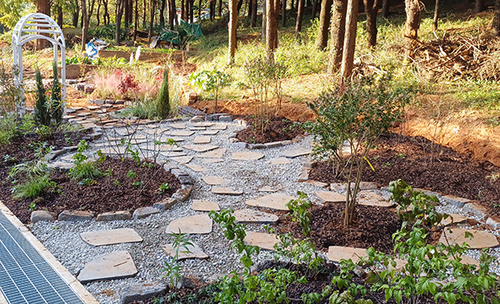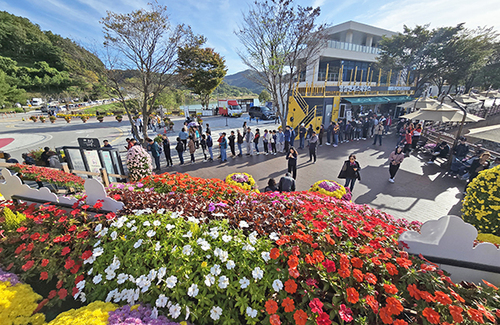| ▲ 전북 고창군 아산면 '병바위' 일원이 아름다운 자연경관과 역사ㆍ문화적 가치를 인정받아 8일자로 국가지정문화재 명승(名勝)으로 지정 예고됐다. / 사진제공 = 고창군청 © 김가영 기자 |
|
전북 고창군 아산면 '병바위' 일원이 아름다운 자연경관과 역사ㆍ문화적 가치를 인정받아 8일자로 국가지정문화재 명승(名勝)으로 지정 예고됐다.
명승은 다른 문화재에 비해 우리나라에서도 120기 정도만 지정된 희소성의 가치와 관광효과가 매우 큰 국가지정문화재며 앞으로 30일간의 지정예고 기간 동안 각계의 의견을 수렴한 뒤 문화재위원회의 심의 절차를 거쳐 국가지정문화재 명승으로 최종 지정될 예정이다.
'병바위'는 병을 거꾸로 세워 놓은 모양 같기도 하고 멀리서 보면 사람 얼굴 같기도 한 묘한 모양을 하고 있으며 높이 35m 정도의 크기로 윗부분이 크고 아래로 내려올수록 잘록하다.
지질암석 풍화작용의 대표적 특징인 '타포니(tafoni = 바위조각이 떨어져 나간 패인 풍화혈ㆍ風化穴)'와 '인천강 하구습지'와 연결되는 주진천의 생태를 관찰할 수 있다.
바위는 소반바위ㆍ두락암(전좌바위) 등 주변과도 잘 어울려 경관적 가치가 크고 바위 주변 두암초당에서 강학에 관련된 다양한 문헌과 함께 시ㆍ글ㆍ그림으로도 오랜 기간 고창현ㆍ흥덕현ㆍ무장현 등에서 지역의 명승으로 역사ㆍ문화ㆍ경관적 가치가 뛰어난 곳이다.
지질학적으로 병바위 일원은 1억5,000만년 전부터 형성된 기암괴석으로 침식으로 생겨난 수많은 단애(cliff = 수직으로 깍아지른 절벽)ㆍ스택(stack = 층층이 쌓인 퇴적암)이 있다.
즉, 유문암질 응회암의 노두를 관찰하고 타포니 학습장소로 적합하고 보존가치 역시 높아 학술적 가치를 인정받았다.
또한 병바위에 착생해 서식하는 덩굴류(백화등ㆍ담쟁이)의 식생학적 가치와 계절에 따라 색을 달리하는 등의 경관적 가치가 훌륭해 명승적 지정 조건인 경관 생태적ㆍ문화적ㆍ역사적 의미가 빼어나다.
특히 병바위는 '여지도서(흥덕 1757)'와 '해동지도(1750년대 초)ㆍ호남읍지ㆍ지방지도ㆍ고창현과 흥덕현(1872)' 등 여러 기록에 호리병 바위라는 뜻의 '호암(壺巖)'으로 표기됐고 병 모양으로 그려져 있는 문헌자료 등도 확인돼 역사성도 갖췄다.
관련된 전설은 '선동마을 뒤 선인봉 반암 뒤 잔칫집에서 몹시 취한 신선이 쓰러지면서 소반을 걷어차자 소반 위 술병이 굴러 떨어져 인천강가에 거꾸로 꽂힌 것이 병바위가 되었다'는 이야기가 전해져 내려오고 있다.
또, 주변의 여러 바위와 함께 명당인 금반옥호(金盤玉壺) 또는 선인취와(仙人醉臥)로 알려져 많은 발길이 이어지고 있다.
이곳은 조선 중기 저명한 유학자인 이황(영남) 및 김인후(호남)와 교류했던 고창의 유학자인 호암 변성온ㆍ인천 변성진 형제의 세거지로 명성이 난 곳으로 두암초당(고창군 향토문화유산)이 자리한다.
아름다운 경관을 지닌 두락암(전좌바위) 중턱에 암굴식의 초당을 지어 강학장소를 마련했고 이와 관련된 인문 역사적 가치가 큰 것으로 평가됐다.
유기상 고창군수는 "아산면 병바위 일원이 고창갯벌 유네스코 세계자연유산 등재에 이어 국가 명승(자연유산)으로 지정됨에 따라 고창군이 진정한 역사와 자연이 공존하는 생태문화도시로 인정받게 됐다"며 "고창갯벌ㆍ고인돌유적ㆍ선운사 등과 연계해 국내 뿐만 아니라 세계적인 역사ㆍ생태문화 관광자원이 될 수 있도록 최선을 다하겠다"고 말했다.
한편 '고창 병바위 일원'은 독특한 형상으로 인상적이고 흥미로운 조망대상(병바위ㆍ두락암ㆍ두암초당)인 동시에 주변 지역을 내려 볼 수 있는 빼어난 장소로도 탁월해 '선운산 도솔계곡 일원'에 2번째로 지정되는 명승이다.
☞ 아래는 위 기사를 구글 번역이 번역한 영문의 '전문'이다.
【Below is the 'full text' of an English article translated from the above article with Google Translate.】
Notice of designation of Gochang Byeongbawi Rock as 'National Scenic Spot'
Cultural Heritage Administration recognized natural landscapes with natural history and culture
Reporter Kim Ga-young
The area of 'Byeongbawi' in Asan-myeon, Gochang-gun, Jeollabuk-do has been recognized for its beautiful natural scenery and historical and cultural value, and has been designated as a nationally designated cultural heritage site as a scenic spot on the 8th.
Scenic spots are nationally designated cultural properties with a very large tourism effect and value of rarity, which is designated only about 120 in Korea compared to other cultural properties. It will be finally designated as a scenic spot.
'Byungbawi Rock' looks like an upside down bottle, and when viewed from a distance, it has a strange shape that resembles a human face.
You can observe 'tafoni', which is a typical characteristic of geological rock weathering, and the ecology of Jujincheon, which is connected to 'Incheon River Estuary Wetland'.
The rocks have great scenic value because they fit well with the surrounding areas such as Sobanbawi Rock and Durakam Rock(Jeonjwabawi Rock). It is a place of outstanding historical, cultural, and scenic value as a local scenic spot.
Geologically, the area of Byeongbawi Rock is a strange rock formation formed 150 million years ago, and there are numerous cliffs(cliff = vertically cut cliffs) and stacks (stack = sedimentary rocks) formed by erosion.
In other words, the outcrop of rhyolite tuff was observed, and it was recognized for its academic value because it was suitable as a place for tarpony learning and had a high preservation value.
In addition, the vegetation value of the vines (flowers and ivy) that are epiphytic and inhabiting the Byeongba rock and the landscape value, such as changing colors according to the season, are outstanding, so the ecological, cultural, and historical significance of the landscape, which is a condition for designation as a scenic spot, is outstanding.
In particular, Byeongbawi is recorded in various records such as 'Yeojidoseo (Heungdeok 1757)', 'Haedongjido(early 1750s), Honam-eupji, local maps, Gochang-hyeon and Heungdeok-hyeon(1872)', etc. )' and documented material drawn in the shape of a bottle, etc.
A related legend has been handed down saying, 'At the feast house behind Seoninbong porphyry behind Seondong Village, a very drunk god fell and kicked the soban, and the wine bottle on the soban rolled down and stuck upside down in the Incheon River, turning into Byeongbawi Rock.
Also, it is known as Geumbanokho(金盤玉壺) or Seoninchwiwa(仙人醉臥), a famous place along with several rocks around it, and many people visit it.
Duamchodang(a local cultural heritage in Gochang-gun) is located here as the residence of the famous Confucian scholars Lee Hwang (Yeongnam) and Kim In-hu (Honam) during the mid-Joseon period. .
A rock cave-style chodang was built on the slope of Durakam (Jeonjwabawi Rock) with a beautiful scenery to provide a lecture site, and the historical value of the humanities related to this was evaluated as great.
Gochang-gun Governor Yu-sang Yu-sang said, "As the area of Byeongbawi Rock in Asan-myeon has been designated as a national scenic spot (natural heritage) following the UNESCO World Natural Heritage listing, Gochang-gun has been recognized as an eco-cultural city where true history and nature coexist." ㆍWe will do our best to become a historical, ecological, and cultural tourism resource not only in Korea but also in the world in connection with the dolmen ruins and Seonunsa Temple."
On the other hand, 'Byeongbawi Rock in Gochang' is an impressive and interesting viewing area (Byeongbawi Rock, Durakam Rock, and Duamchodang) with a unique shape and is excellent as an excellent place to look down on the surrounding area. It is a scenic spot designated as.





















 많이 본 뉴스
많이 본 뉴스











